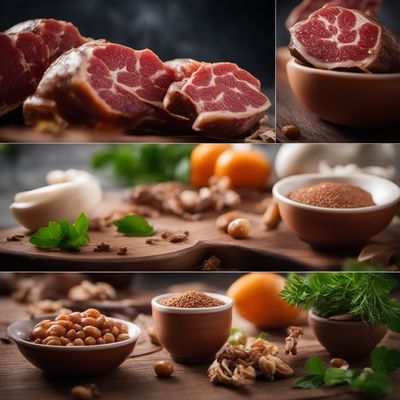
Ingredient
Ratites carcase
The Exotic Delicacy: Ratites Carcase Unveiled
Ratites carcase refers to the carcass of large flightless birds such as ostriches, emus, and rheas. It is characterized by its lean and tender meat, which is darker in color compared to traditional poultry. The meat has a rich, gamey flavor with a hint of sweetness, and its texture is similar to beef, making it versatile for various cooking methods. The carcase is typically composed of different cuts, including the breast, thighs, drumsticks, and wings, each offering a unique taste and texture. Its appearance showcases a deep red color with minimal fat marbling, making it a healthier alternative to other meats.
Origins and history
Ratites carcase has a fascinating history rooted in different cultures around the world. Ostriches, emus, and rheas are native to different regions, with ostriches originating from Africa, emus from Australia, and rheas from South America. These birds have been hunted and consumed by indigenous communities for centuries, providing a valuable source of sustenance. In recent years, ratites carcase has gained popularity in the culinary world, with chefs and food enthusiasts appreciating its unique taste and texture.
Nutritional information
Ratites carcase is a nutrient-dense ingredient, rich in high-quality protein, iron, and B vitamins. It is also lower in fat compared to traditional meats, making it a healthier choice for those conscious of their dietary intake.
Allergens
Ratites carcase may pose allergenic risks to individuals with poultry allergies. It is important to exercise caution and consult with a healthcare professional if you have any known allergies.
How to select
When selecting ratites carcase, look for cuts that are fresh, firm, and free from any unpleasant odors. The meat should have a deep red color, indicating its freshness. Additionally, ensure that the packaging is intact and properly sealed to maintain its quality.
Storage recommendations
To maintain the freshness and quality of ratites carcase, it is best to store it in the refrigerator at a temperature below 40°F (4°C). If the carcase is not going to be used within a few days, it can be stored in the freezer for an extended period. Properly wrap the meat in airtight packaging or freezer bags to prevent freezer burn.
How to produce
Ratites carcase is typically produced by specialized farms that raise ostriches, emus, or rheas. As an amateur, it is not recommended to attempt raising these birds due to their specific needs and requirements.
Preparation tips
Ratites carcase can be prepared using various cooking techniques such as grilling, roasting, or pan-searing. Due to its lean nature, it is important to avoid overcooking to prevent dryness. Marinating the meat prior to cooking can enhance its flavor and tenderness. Ratites carcase is often used in dishes such as steaks, burgers, stir-fries, and stews, allowing its unique taste to shine.
Culinary uses
Ratites carcase is commonly used in a variety of dishes, including ostrich steaks, emu burgers, and rhea stir-fries. Its rich flavor and tender texture make it a popular choice for those seeking a unique and adventurous culinary experience.
Availability
Ratites carcase is commonly available in regions where ostriches, emus, or rheas are farmed, such as Africa, Australia, and parts of South America.
More ingredients from this category » Browse all

Goat carcase
The Wholesome Base

Duck carcase
The Essence of Duck: Unveiling the Secrets of Duck Carcase

Horse carcase
The Noble Beast: Horse Meat

Asses-mules-hinnies carcase
The Forgotten Meat

Bovine carcase
The Foundation of Flavor

Chicken carcase
The Foundation of Flavor: Unleashing the Potential of Chicken Carcase

Wild boar carcase
Untamed Bounty: Wild Boar

Sheep carcase
The Art of Lamb: Exploring the Versatility of Sheep Carcass

Goose carcase
The Flavorful Foundation

Turkey carcase
The Versatile Turkey Carcase

Rabbit carcase
The Art of Rabbit: Unlocking the Culinary Potential of Rabbit Carcass

Pig carcase
Pig Carcase: A Versatile Ingredient